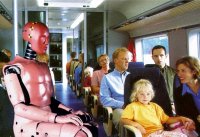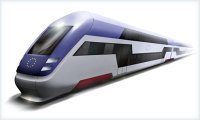EURailSafe.net
Welcome



This website addresses Passive Safety issues for all forms of rail transport: passenger, regional, high speed, metro and light rail (trams) systems. It will make public new priorities for safety in the rail industry.
Passive Safety can be defined in two distinct phases during a train crash event:
- The primary collision, where the initial kinetic energy is progressively dissipated by means of plastic structural deformation. In this phase occupant compartment integrity and acceptable vehicle acceleration levels (crash pulses) are the most important design requirements to be considered.
- The secondary collision, where the occupant will be subject to a great variety of potentially harmful occupant/interior or occupant/occupant contacts. Design requirements must involve the aspects of interior layouts, acceptable severity levels and biomechanical response to vehicle crash pulses.
The main aim of the Eurailsafe site is to improve the exchange of information and experience between experts drawn from its Partners and Members and transfers knowledge and best practice within the various sectors and achieve the development of the partnership for future research, industrial and infrastructure cooperation.
It does not operate in isolation. The intention is to compliment the activity of existing safety-related projects and ensure that the work is aligned with the strategic research objectives of the European railway system through giving open access to information from previous and ongoing Rail Safety projects such as:
- Traincol
- Safetrain
- Safetram
- Trainsafe
- Safeinteriors
However it should be emphasised that the goal of a rail system is to transport passengers or freight as quickly, efficiently and safely as possible. Ensuring that safety is maintained or improved requires a systems approach to optimisation. Due to the complexity of the rail network and the multitude of interacting sub-systems, it is essential that a holistic approach plans for safety improvement whilst giving full consideration to all aspects of rail transport. Furthermore, maintaining or improving safety levels whilst simultaneously implementing European interoperability is a major challenge for all stakeholders in rail transport.
The information contented and the network encouraged by this website will aid the Industry to:
- Move from national safety and security philosophies to a harmonised European approach.
- Align national codes governing safety in operation, certification, testing, acceptance and maintenance.
- Define common rules for railway operation across a single European rail network.
- Develop modelling tools to improve the understanding of rail vehicles and passenger dynamics, particularly with respect to crash behaviour.
Furthermore it will aid the Industry to:
- Propose enhancements to safety standards within the rail industry.
- Improve global system safety through vehicle research, procedural systems analysis and training.
- Integrate the land transport industries by cross-fertilisation and full co-operation between researchers, systems integrators and suppliers.
- Recommend innovative research (leading to individual proposals), priorities for future research actions and identify (virtual) centres of excellence.
|
UNIFE, the Union of European Railway Industries |
Site programming and design by |
